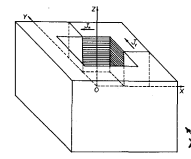I'm working on a finite element model as part of a line of research. Specifically I'm consider using vector finite elements (i.e 3 values x,y,z per node) to solve the Poisson equation in magneto-statics.
To ensure my code is functioning properly, the aim is to first reproduce the results set out in the following pair of papers:
N. Demerdash, T. Nehl and F. Fouad, "Finite element formulation and analysis of three dimensional magnetic field problems," in IEEE Transactions on Magnetics, vol. 16, no. 5, pp. 1092-1094, September 1980.
doi: 10.1109/TMAG.1980.1060817
keywords: {FEM;Finite-element method (FEM);Magnetic analysis;Finite element methods;Magnetic analysis;Magnetic fields;Coils;Closed-form solution;Inductance measurement;Maxwell equations;Geometry;Magnetic field measurement;Current density},
URL: http://ieeexplore.ieee.org/stamp/stamp.jsp?tp=&arnumber=1060817&isnumber=22843
N. A. Demerdash, F. A. Fouad, T. W. Nehl and O. A. Mohammed, "Three Dimensional Finite Element Vector Potential Formulation of Magnetic Fields in Electrical Apparatus," in IEEE Transactions on Power Apparatus and Systems, vol. PAS-100, no. 8, pp. 4104-4111, Aug. 1981.
doi: 10.1109/TPAS.1981.317005
keywords: {Finite element methods;Magnetic fields;Magnetic flux;Transformer cores;Magnetic anisotropy;Perpendicular magnetic anisotropy;Magnetostatics;Magnetic field measurement;Integral equations;Student members},
URL: http://ieeexplore.ieee.org/stamp/stamp.jsp?tp=&arnumber=4111101&isnumber=4111054
But I'm having difficulties defining the current density within my code. The model considers a aircored coil with rectangular cross section - akin to a rectangular current loop, but in 3D.
I know the cross sectional area of the coil region, the DC current carried by the coil as well as the number of turns of wire, the wire type is AWG #16. The winding height, inner length and outer length of the coil geometry all also known.
The overall simulation is a 'black box' simulation with the outer faces far enough away from the coil that approximately all of the flux density will be enclosed leading to Dirichlet boundary conditions on the outer surface.
My Attempt to Discretise the current density.
Simplistically, |J| = Current / Cross Sectional Area. For a loop with N_turns of wire, |J| = I N_turns / CA. In the 'bulk' of the coil, i.e where there is only current density in a single direction I think this may be a reasonable way to numerically describe the system with Jx/Jy = |J| in those sections.
The point I'm confused about is how to describe the current density in a discrete fashion in the corner regions where the two components are mixed together.
My best attempt for this region is to consider that |J| should be constant throughout the coil giving Jx = Jy = |J|/sqrt(2) at the corners however this doesn't account for the varying cross sectional area of the coil in the corner regions. All in all I feel like this is a simplistic description and I am subsequently missing parts of the model.
I know to first describe something well in a discrete fashion it is important to understand the continuous description however I'm struggling to find any resources/develop a framework to consider this approach either.
Any thoughts, directions or advice would be greatly appreciated.
Thanks for the time.






